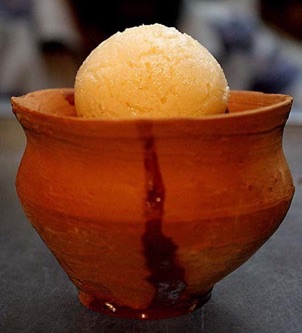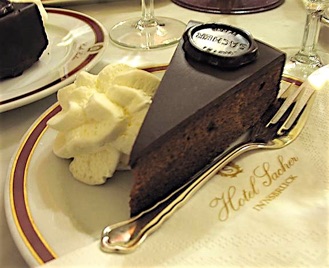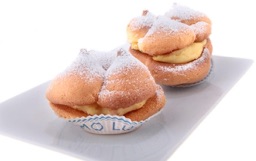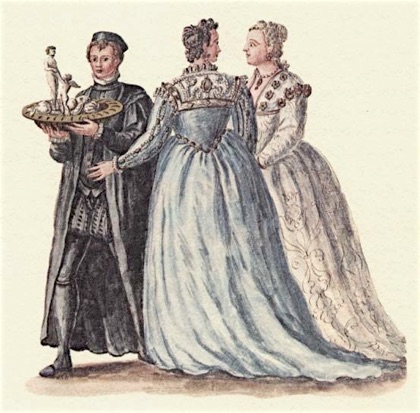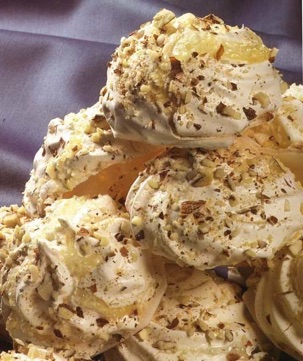This variation on
rossogolla (see below) is dyed with saffron and filled with a nut mixture flavored with cardamom powder
.
A sort of teepee of
éclairs and cream that is meant to resemble a nun’s habit. According to the nineteenth-century pastry chef and author Pierre Lacam, the religieuse was originally created at the Frascati patisserie in Paris in 1836.
réligieuse
A sort of egg-rich doughnut (made in the shape of a torus) and flavored with lemon rind and dusted with sugar. Current recipes tend to use baking powder as a leaven.
rossogolla, rasgula India, Bangladesh
A spongy dumpling made by boiling balls of fresh curd (
chhana) in sugar syrup. In Kolkata, the invention of this local favorite is credited to Nobin Chandra Das who is said to have created it in 1868. However natives of nearby Orissa dispute this with great passion.
rossogolla, rasgula
This is made exactly the same way as rossogolla except that in this case it is finished off in a milk-based and saffron-tinted syrup. The result is creamy, delicate, and a little like a French île flottante, but less insipid.
An early (1800 or so?) drop cookie or small cake. Possibly the ancestor to the American drop cookie? The name comes from rout, “A fashionable gathering; a large evening party or soirée of a type fashionable in the 18th and early 19th centuries.” (OED) Jane Austen mentions “rout-cakes” in Emma.
Sachertorte (also Sacher-Torte) Austria
Sally Lunn US, UK (dated)
An Easter dessert typical of Puglia. It is a sort of pie made by filling a short crust dough (flour, sugar, eggs, lard, lemon rind) with a sweetened ricotta filling. The top is typically decorated with one or more whole eggs. Other versions are made quite differently, resembling the Calabrian cuzzupa.
A liquid lemon sorbetto from the northern region of the Veneto Italy. “It is basically an intermezzo drink to help move through different courses made of lemon sorbetto, prosecco wine and vodka. Stored frozen and served chilled in flute glasses.“ Thanks to Leonardo Mazzero
Photo: Federico Deidda
sorbet France, US, ice UK, sorbetto Italy
A fruit or or other dairy-free frozen dessert made in an ice cream freezer. Before 1900 or so, confusion reigns when it comes to the term. Before about 1800 or so, in France, sorbet referred to a chilled soft drink and in Italy a sorbetto was largely indistinguishable from what we would call a gelato today.
spongade Italy (16th-17th century)
A late renaissance Venetian term used for sugar sculptures. There were often designed by noted artists to be used as opulent centerpieces, and often gilded just to prove the host’s extravagance.
Engraving after Giovanni Grevembroch (18th Century)
sponge cake US, UK, génoise France, pan di spagna Italy, Biskuit Austria, Germany, bizcocho, vizcocho (dated) Spain
Sponge cake is made by beating eggs to a foam and then folding in flour, ground nuts, cocoa and/or other flavorings. A number of variations exist: sometimes the eggs are separated and the yolks and whites beaten individually, at other times the eggs are beaten whole, occasionally the eggs are beaten over a low heat source. The technique may well have originated in Spain since the earliest Italian recipes call it
pan di Spagna or “bread of Spain” and early Portuguese recipes referred to it as
paõ de Castella, or “bread of Castille.” The Japanese still call it
castella. Since the recipe for
pan di Spagna was used to make the more delicate kind of
biscotti in renaissance Italy, the French picked up the habit of calling their egg-leavened cake
biscuit, a term that, in France, had once referred exclusively to ship’s biscuit or hard tack. Eventually the term came to mean primarily small cakes or cookies.
strudel Central Europe, rétes, Hungary
To make strudel, apples, cherries, cottage cheese and even cabbage are rolled in several layers of paper-thin dough. Though superficially similar to filo, strudel dough is stretched rather than rolled and may well have been developed independently in central or southeastern Europe. One of the earliest recipes for such a stretched dough appear in a dish called “Torta ungaresca” (Hungarian pie) in a 14th century source.
suspiros de Santa Catarina Portugal
Literally, “Saint Catherine’s sighs,” these are made by piping (French) meringue onto a thin wafer base. This is sprinkled with almonds and baked until crisp.
Photo: Antonio Rosado from
Doçaria Conventual Portuguesa, 2004
An old-fashioned steamed pudding make by setting a whole lemon in a mixture of sugar and butter and encasing all this in suet pastry. The name presumably comes from the fact that when the pudding is sliced open, the marmelade-like filling spills out creating a sort of “pond” around the dessert.
Thanks to Jennifer Yee.



















